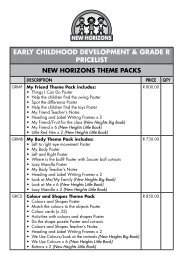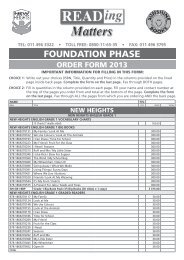shared reading - Reading Matters
shared reading - Reading Matters
shared reading - Reading Matters
Create successful ePaper yourself
Turn your PDF publications into a flip-book with our unique Google optimized e-Paper software.
SHARED READING<br />
What is <strong>shared</strong> <strong>reading</strong>?<br />
The teacher reads a Big Book with the children and then teaches skills in context. The print in the Big Book<br />
must be big enough for all the children to see each word clearly. The teacher points to each word as she<br />
reads but keeps to the natural pace of the story. Children are encouraged to join in with the <strong>reading</strong> once they<br />
know the words. Shared <strong>reading</strong> is an important step in developing <strong>reading</strong> skills because it is a bridge<br />
between <strong>reading</strong> aloud to children and independent <strong>reading</strong> by the children. Shared <strong>reading</strong> with the children<br />
allows them to take over the task of <strong>reading</strong> gradually at their own pace.<br />
Why is <strong>shared</strong> <strong>reading</strong> suitable for English first additional language<br />
learners?<br />
Shared <strong>reading</strong> has been found to be very valuable in teaching children who speak English as a second<br />
language. Research shows that, in less than a year, children are <strong>reading</strong> with greater comprehension, know<br />
more sight words, and are better able to repeat simple English structures orally. The new language is learned in<br />
a situation where motivation is high. (Early Literacy in the Classroom, Helen Depree and Sandra Iversen, 1994).<br />
How does <strong>shared</strong> <strong>reading</strong> help to develop literacy?<br />
There is evidence that <strong>shared</strong> <strong>reading</strong> develops positive feelings towards stories. Book experiences take<br />
place in a relaxed, secure situation because<br />
◆ children read at their own pace and join in when they want to, thus developing confidence in the <strong>reading</strong><br />
process<br />
◆ it focuses on meaning and fun<br />
◆ rich language can be used even for beginner readers<br />
◆ the books support early <strong>reading</strong> with rhyme, rhythm and repetition<br />
◆ <strong>reading</strong> strategies such as predicting, checking, confirming and self-correcting at the level of letter, word<br />
and sentence are taught in context<br />
◆ it extends knowledge of phonics, sight words and vocabulary words
◆<br />
◆<br />
it develops concepts of print such as directionality, punctuation, use of bold<br />
type etc.<br />
it helps teachers cope with a range of <strong>reading</strong> abilities as less able readers are<br />
supported.<br />
What books are suitable for <strong>shared</strong> <strong>reading</strong>?<br />
Shared <strong>reading</strong> books should be produced in Big Book format and should have<br />
◆ print that is big enough to be <strong>shared</strong> with the whole class<br />
◆ clear illustrations that support the text<br />
◆ a strong storyline that engages the children<br />
◆ interesting events that encourage prediction about what could happen next<br />
◆ use of natural flowing language that encourages joining in through rhyme,<br />
repetition and rhythm.<br />
How do you give a <strong>shared</strong> <strong>reading</strong> lesson?<br />
1. Set the scene<br />
Make <strong>shared</strong> <strong>reading</strong> enjoyable by gathering the children around you so that<br />
they can all see the text. Ensure that you can read the book comfortably by<br />
using an easel or balancing the book against the board. You will need to point<br />
to the words as you read so have a pointer ready. Talk about the words and<br />
pictures on the cover. Ask questions to link with what the children already know<br />
and to make them want to find out what is in the book. Keep this part of the<br />
lesson very brief.<br />
2. Read the story<br />
Read the text with the children. Point to each word but do not make the pace<br />
slow. Make the story as interesting and exciting as you can. Encourage<br />
prediction. Remember to give the children the best model of the way a<br />
proficient reader reads. <strong>Reading</strong> for meaning is the main purpose.<br />
3. Re-read the text with the children joining in<br />
This time give the children as many opportunities to join in as possible.<br />
4. After <strong>reading</strong>, have the children<br />
• recall events in sequence<br />
• wonder about why things happened<br />
• observe things that interest them in the illustrations<br />
• connect the events to their own lives.<br />
Shared <strong>reading</strong><br />
has been found<br />
to be very<br />
valuable in<br />
teaching<br />
children who<br />
speak English<br />
as a second<br />
language.<br />
(Early Literacy in the<br />
Classroom, Helen Depree<br />
and Sandra Iversen, 1994)<br />
How do you teach <strong>reading</strong> skills using <strong>shared</strong> <strong>reading</strong>?<br />
Shared <strong>reading</strong> allows a variety of skills to be taught in the context of the story in<br />
the Big Book. In the Foundation Phase you can teach<br />
• high-frequency words<br />
• new vocabulary words<br />
• phonics such as initial letters, word families, letter clusters etc.<br />
• concepts of print such as directionality, punctuation, bold print etc.<br />
• language structures such as tenses, prepositions, adjectives etc.<br />
“Educating South Africa’s future.”<br />
4 Handel Road, Ormonde, 2091 • PO Box 30994, Braamfontein, 2017<br />
Phone: (011) 496-3322 • Fax: (011) 496-3795<br />
Tollfree: 0800 11 65 35





